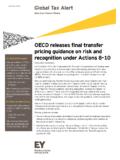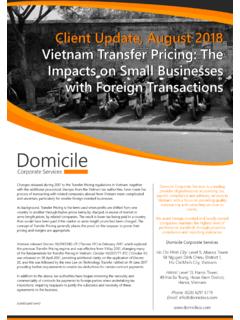Transcription of Risk Transfer Transportation Agreements Article
1 Risk Transfer Issues in Motor Transport Agreements By Jim Mahoney James F. Mahoney, PLC. Indemnity. The oldest and most widely used method of shifting risk of loss to another party; it is commonly used today under terms of a written agreement. All insurance Agreements , even as far back as Roman traders, are based upon the theory of indemnification: If you pay me X, I will pay you Y if the agreed upon loss occurs. Y payments have bankrupted and continue to plague the best and brightest. For purposes of this report, we will first tackle risk shifting between and among motor carriers, logistic providers and shippers or beneficial owners of Later on we'll address what's on the horizon as to new strategies to consider as shippers approach problems created by the recent flurry of anti-indemnity laws now observed by a majority of states.
2 Indemnification: hold harmless, defense, indemnity clauses in Transportation An enforceable indemnity clause has been the most dependable method for shippers or owners of freight to facilitate the avoidance of their own negligence and place it with transport companies. Since deregulation, but more so in the last decade, shippers have gone a bit over-board in shifting all responsibility to the carriers, well, just because they could and can. Recently, following a trend in oil fields and general construction, and with the urging of state transport associations, a large number of state legislatures have passed bills outlawing certain types of indemnity in Transportation Agreements .
3 Indemnity Clauses in Transportation contracts have become burdensome to transporters and a safety issue for the public: 1. As an outgrowth of generally accepted risk financing techniques, theoretically at least, the parties to a transport contract enter into the agreement on equal footing and are free to accept or reject terms that are deemed unfair or too risky. Shippers argue that the price for risk shifting is built in the transport pricing, an argument that no one takes seriously in an industry with hundreds of thousands of capacity providers and servicers.
4 2. While insurance principles are broad-based and spread risk among many insureds, indemnity clauses in transport contracts are targeted devices; and most often, the weaker party holds its nose and hopes that their personnel and their capital - are not lost in the fulfillment of the task. 3. Shippers having this leverage evaluate the manner in which they can off-load risk in the most efficient fashion as they move cargo. Shippers look at factors deciding whether: 1. The laws and contract terms discussed herein relate to all the many additional entity types in the Transportation industry.
5 For purposes of simplicity, we refer mostly to shippers and transporters. There are, of course, many exceptions and exemptions in the laws and contracts. 1 James F. Mahoney, PLC June 2011 a) to retain the risk of loss of an occurrence that its operation may cause;. b) Transfer the risk to an insurer in exchange for some amount of premium;. c) Transfer the risk to the counter-party transporter via contract using strong indemnity language. Each of the above scenarios has a degree of cost uncertainty, but the last one shifting the risk to an unequal counter-party, can be the least expensive and more certain.
6 Well-crafted indemnity language is more than just risk shifting; it's a method of obtaining additional insurance that can relieve the shipper of premium, legal and administrative costs. Reasons Raised Against Unfair Indemnity Terms: It creates a moral hazard because such terms encourage the shipper to be careless and abandon its responsibility to protect persons and property on its own premises or those in transit due to negligence in loading / rigging / and unloading. Indemnity can Transfer risk associated with strangers to the agreement, to the public, and in many instances, agents or employees of the transporter.
7 This last scenario is worsened by the fact that the employer may be obligated under both liability and Workers' Comp to compensate its own personnel, even when the shipper was solely or mainly at fault. It hides the potential loss exposure by shifting the risk to one who is unable to take precautionary measures of preventing loss created by the shipper in the truckload industry shipper load and count, or pre-loaded and sealed trailers. It creates exposure for all in warehouse, dock and retail locations. And lastly, shifting the hidden risks to the motor carrier and /or its insurer prevents carriers and brokers from pricing freight charges properly and prevents insurers of transporters from underwriting correctly.
8 Transporters can't predict who will sue them if they are indemnitors for premises liability claims only because their trucks and personnel are on site. Transport insurers are asked to underwrite transport risks and never know what Agreements the transporters might sign or what risks they are actually underwriting. Indemnity Clauses: force transporters to price uncertainty into rates; and force them to incur exposure to unknown and unanticipated risks. Paying for losses arising from an indemnity agreement may persist for years in risk and insurance costs.
9 Force transporters to compete with peers who are domiciled in states with anti-indemnity laws. Variables facing Transporters who agree to Indemnity: 2 James F. Mahoney, PLC June 2011 no certainty about the safe operations of entities unrelated to customers, many of whom are foreign or out-of-state and who load or unload in and around or even just near- transport equipment;. absolute inability to forecast total cost of risk of the contract; thus, inability to calculate return on lanes or customers;. a decision to blindly sign risk shifting contracts just to stay in business.
10 Indemnity clauses alter existing law of apportioning fault among negligent parties, forcing the counter-party to assume risk regardless of the fault of the shipper or of a stranger to the contract who actually caused the loss. Most state laws apportion fault under comparative fault among responsible parties. Indemnity clauses supersede existing, well-functioning law to the detriment of transporter companies. The map that follows illustrates the states with enacted and proposed anti-indemnity laws. Although there are repeating patterns in some laws, and a model law was proposed by the ATA, an analysis of each contract lined up against each statute is absolutely necessary in order to determine rights, exit strategies and fully voidable indemnity terms.





